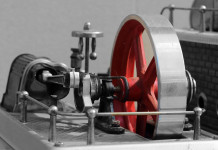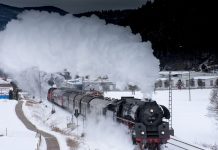Hello again, all you steam engineers and old iron enthusiasts. Have you been to a show yet this year ? Sam Moore told us a few weeks ago that he had been to a show a bit further west. One that I think featured a particular make, which happens quite often these days.
Come to think of it maybe it always did happen that way. Our show at first had only one traction engine — a 12 hp Case. Pioneer had several but, a main feature was always Morgan Hill’s Westinghouse.
National threshers most always had a variety but their founder and president for the first 25 years, LeRoy Blaker, was a Port Huron man, and he always saw to it that make was prominent. But why have a show at all ?
Socializing
One of the good reasons is fellowship, of course. If you have been to a particular show for a number of years, you are very likely to meet some folks you have known for a while.
I went to the Trumbull County show recently, and chatted with at least eight folks I knew from past shows. That show is one of my favorites because it is early, easy to get to, and always has a bunch of good engines.
Another important reason is deadlines. We have all observed that if it wasn’t for the upcoming show, few of us would get any of our machines tuned up and painted to show off. And of course showing off that “new” piece of iron is important too. Most of the competition is good natured, but sometimes the heat gets turned up a bit.
Another aspect of most shows is education. That is, showing the younger generation how things were done in the “good old days.” Previous to 1900 if you had a job to do that needed 40 or 50 horsepower or more, steam was about your only choice.
Gas engines were being developed, but were still relatively small and crude. Steam power had been around for many years and was well understood and well developed for railroads and mill work. Most early oil wells and water wells too, were steam drilled.
Supper
And we haven’t mentioned threshing the grain from the shocks. People need to be reminded that in the 1800s bread did not come from a store in a plastic bag.
One of the things I’ve learned studying my family roots, was the prevalence of, and importance of, a large vegetable garden. Those especially who lived out in the country were faced with a tough and thin table if they did not grow enough and preserve it.
My grandad used to tell me of the bushels of potatoes his dad grew each year, and no doubt they were needed with 15 children plus mom and dad around the table. My how times have changed. The late Leonard Stephens, of Meadville, called steam engines the machines of plenty — no more starvation or famine in North America. Let’s hope those threats never come back to haunt us.
Displaying historical engines and machinery has always been a big item, and will remain so. Most shows have restored equipment that will do the sawing, threshing, baling, shingle cutting, pumping and grinding as it was done more than 100 years ago.
The number of men who actually made a living with steam power are dwindling as the years go by, but most of them could tell you how superior steam was to gas power for sawing and other heavy jobs. The power produced just in raw horses, and the torque patterns are so different from gas as to be amazing to the uninitiated.
Attraction
Of course having different makes of engines on the show field together is an attraction, as it allows us to make comparisons and see how various parts of engines differ.
We see single cylinder engines most of all, then double simples, and compounds and return flue boilers and undermounts.
Some use the boiler itself for the frame, holding all the other parts together, while others have a frame to carry the wheels and gears and often advertised the boiler was under less strain that way.
I don’t know of any cases of boiler failure blamed on those stresses, as the main cause was nearly always low water, sometimes coupled with corrosion. Many old engineers will tell you a boiler will spring a leak long before it will explode, and I am quite confident they are right.
Use caution
In fact I have been told that a boiler with sufficient water in it will never explode, as it will leak first as the pressure rises. But the thought of all that pressure and hot water and steam puts most people on their guard. I have walked away from engines that were being operated unsafely, and have heard others say they have too.
I would never strike a match to light a fire in an unsafe engine, and only a fool would. But there have been occasions when fools went to their reward, and took innocent friends and bystanders along with them.
Several highly-educated purists will argue a boiler does not explode, that the steam and hot water does, but such nitpicking and splitting verbal hairs is rather meaningless to the individual being scalded and/or tossed through the air when such an accident happens.
Money
Providing club income and storage for machinery is a big impetus for some shows. Many shows are struggling to make much of an income lately, as there is a lot of competition for the public’s money. Several shows have found the gold mine that keeps them well supported.
Perhaps chief here are shows with railroads that haul people around the larger showgrounds. For a nominal fee that people are willing to pay, and with long hours of running, they bring in a nice income much beyond the single gate fee most shows depend on. Buildings for storage double as covered display space during show time.
An auxiliary benefit of shows is raising interest in certain areas of collection. We have noticed this effect at our show several times. At first our printing operation led to the donation of so many old-fashioned, cast iron letter presses that we had to expand the building. Not to mention the number and variety of type fonts offered.
I ran across a very nice, unusual display at a Canadian show, consisting of hay forks of the sort that were used to lift loose hay into haymows of barns.
Creating a market
The owner told me he went often to old farm sales and noticed one fall that auctioneers were begging to get a quarter or 50 cents for such obsolete iron. So he set a goal for himself: to buy all he could for less than two dollars during the next sale season.
The result was he owned more than 20 forks of a goodly variety that made up his display — and what’s more, people noticed, so he could no longer buy them so cheaply by the end of the next year. He had created a market for them just by raising the price.
One of our members has had a very nice display for several years now, of old coffee pots, food grinders and other household machinery no longer of much use.
Another area of great interest, especially to the hobby’s magazines, is old pictures. Many shows have a wall or two of old pictures on display getting their share of attention. Often folks will go home and dig out their own old shots and add them to the display, or send them to the publishers to share with all of us.
Meanwhile the photos get reproduced and preserved for posterity to see and enjoy.
All these things from the desire to make steam and play like the good old days.












